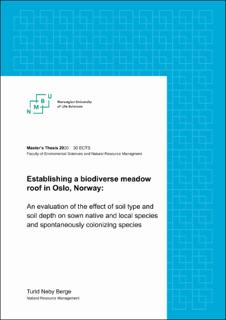| dc.description.abstract | The loss of biodiversity is happening faster now than ever in human history, being mainly driven by changes in land use. Concurrently, cities are expanding and are expected to reach over 1.2 million km2 within 2030. The question arises as to whether urban architecture can provide win-win solutions benefitting urban expansion, economic growth and preservation of biodiversity. Green roofs have the benefit that they do not compete with other building activity, simultaneously supporting ecosystem services like storm water management, temperature regulation and those related to green vegetation. Now, scientists are requesting that green roofs are considered as a tool for preserving biodiversity to a higher extent.
This main aim of this study was to investigate how three soil types in factorial combination with two soil depths affected the establishment of a biodiverse meadow roof in Oslo, the capital of Norway. Twenty-six native and local meadow species were sown with 15 seeds each in 18 plots simulating green roofs in summer 2019. The six treatments mainly manipulated soil nutrients, soil pH, soil water-holding capacity and soil moisture. Meadow roof establishment was evaluated based on seedling emergence, survival and death, and flowering probability and mortality, as well as diversity indices and above ground biomass (AGB). Both sowed species and spontaneously colonized seedlings were recorded.
The results demonstrated that it is possible to establish meadow roofs in Oslo, but supplementary irrigation in dry periods seem necessary to prevent seedling death. 21 out of 26 sowed species and at least 21.2% of all sowed seeds emerged and survived the summer. 1058 colonized seedlings were recorded, representing 37 different species. It may seem like colonized seedlings can affect green roof vegetation considerably, as the domination of two colonized species reduced the Shannon Wiener diversity in the plots they inhabited. Few interactions between soil type and soil depth were recorded, and no singular treatment was best in terms of the variables measured. Based on the results, soil type SC and soil depth 30 cm seem most promising in terms of meadow roof establishment, relating to the highest nutrient content and water-holding capacity. The results suggest that meadow roofs need to have a higher soil water and nutrient content than meadow ground sites. Yet, a multitude of research done on green roofs recommend carefulness when interpreting data from new established roofs, as succession and interspecies competition imposes changes in plant communities over time. Consequently, this experiment should be followed over the next years to determine the long-time effect of the treatments on meadow roof performance. | en_US |

